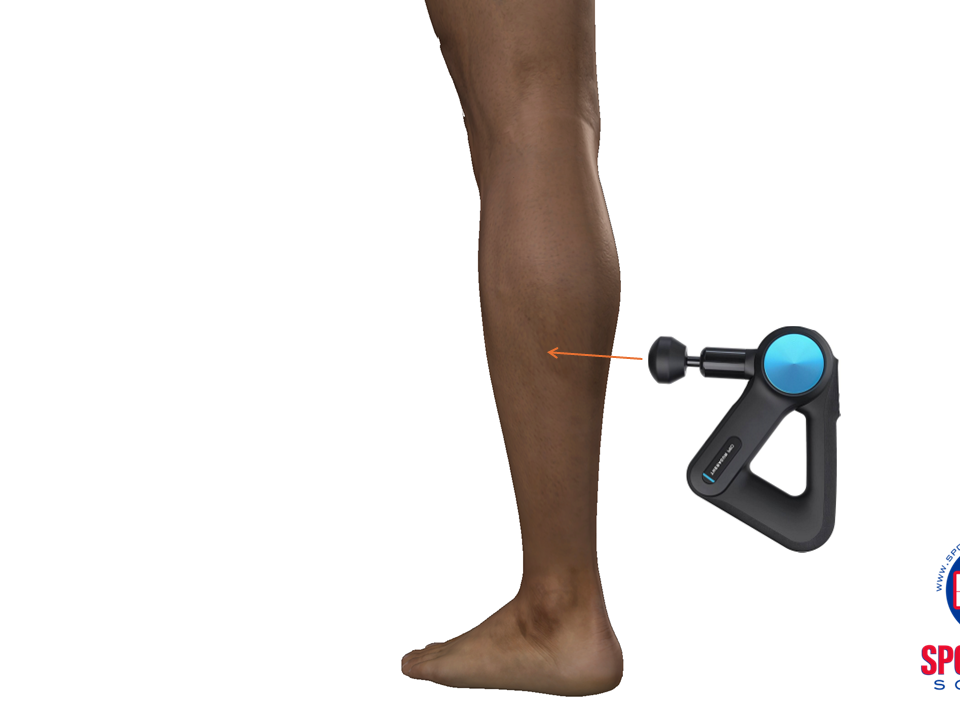
SCAPHOLUNATE LIGAMENT DISRUPTION
May 8, 2014HOOK OF HAMATE FRACTURE
June 4, 2014Posterior Impingement of Elbow

Description: The olecranon of the elbow articulates with the trochlea of the humerus. The posterior aspect of the ulna includes the olecranon process which limits the elbow from extension when it comes in contact with the olecranon fossa and associated fat pad. Posterior elbow impingement has been also been referred to as “valgus extension overload” and “pitcher’s elbow” and involves a repetitive compression injury to the posterior elbow. There is an association in ~ 25 % cases with cubital tunnel syndrome.5
Figure 1 – Anatomy of Elbow (Lateral)
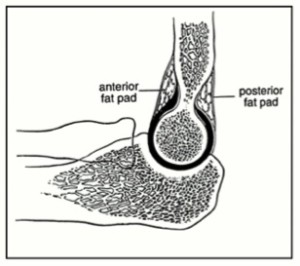
Injury Mechanism: Snapping/rapid full extension of elbow repetitively – Triceps snaps, press-ups, chest press, dips, throwing. The condition is particularly common in throwing athletes and can be associated with UCL laxity or insufficiency.
Differential Diagnoses: Olecranon bursitis, posterolateral instability, osteoarthritis, osteochondritis dissecans, osteochondral defect, olecranon stress fracture, snapping triceps syndrome, ulnar nerve subluxation.
Exam: An effusion may be present.
Range of motion may be preserved but loss of extension is commonly present. Pain should be present where the olecranon process comes in contact with olecranon fossa with terminal passive extension, and active extension. The posteromedial olecranon may also be tender to palpation. Occasionally crepitus and or locking is present in the posterior elbow.2,4 Neurological exam, supination and pronation, as well as power are preserved.
Investigations:
Xray – May reveal olecranon process osteophytosis, posteromedial olecranon fossa osteophytosis. Loose bodies in olecranon fossa may be present. Xray can also appear normal
Figures 2-5 – Xray of elbow of 44 yo with posterior impingement of elbow and olecranon process osteophytosis ( AP, lateral, oblique olecranon, oblique radial)
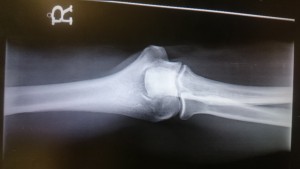
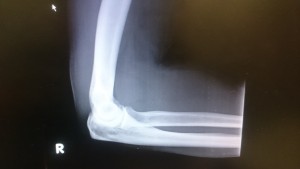
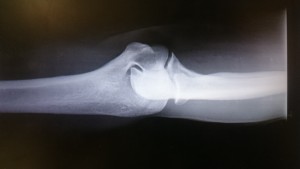
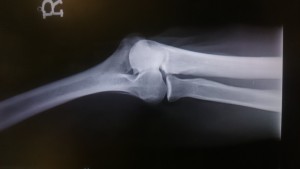
CT – Will provide greater sensitivity than X-ray when looking for loose bodies or osteophytosis leading to posterior impingement.
MRI – chondrosis of the posterior trochlea and the anterior, medial olecranon as well as subchondral edema.3
Management:
Conservative: Modification of activity – to reduce snapping into terminal extension in affected elbow. This should include an initial period of rest to reduce symptoms ie. break from throwing or hyperextending elbow. Physiotherapy may be required to address associated biomechanical related issues for throwing athletes. This may include scapular function, rotator cuff rehabillitation, and/or addressing the patient’s triceps contractility in relation to biceps and brachialis elasticity.
Surgical: Arthroscopic resection of olecranon process osteophytes and debridement in the posterior joint may be of further benefit to the athlete.1
Dr. Neil Dilworth (Nov 18, 2016 PR – WC, Update Jan 3, 2018 – ND)
References:
- Rahusen FT, Brinkman JM, Eygendaal D. Arthroscopic treatment of posterior impingement of the elbow in athletes: a medium-term follow-up in sixteen cases. J Shoulder Elbow Surg. 2009 Mar-Apr;18(2):279-82. doi: 10.1016/j.jse.2008.10.015.
- Chumbley EM, O’Connor FG, Nirschl RP. Evaluation of overuse elbow injuries. Am Fam Physician. 2000 Feb 1;61(3):691-700. Review.
- Cohen SB, Valko C, Zoga A, Dodson CC, Ciccotti MG. Posteromedial elbow impingement: magnetic resonance imaging findings in overhead throwing athletes and results of arthroscopic treatment. Arthroscopy. 2011 Oct;27(10):1364-70. doi: 10.1016/j.arthro.2011.06.012.
- Eygendaal D, Safran MR. Postero-medial elbow problems in the adult athlete. Br J Sports Med. 2006 May;40(5):430-4; discussion 434. Review.
- https://www.orthobullets.com/sports/3080/valgus-extension-overload-pitchers-elbow


